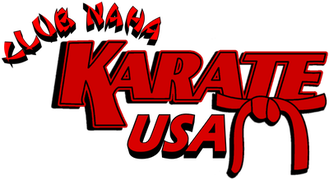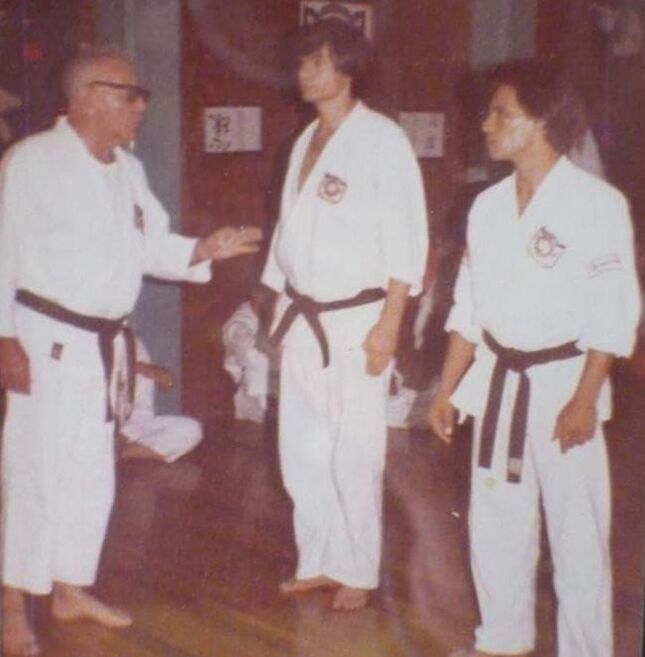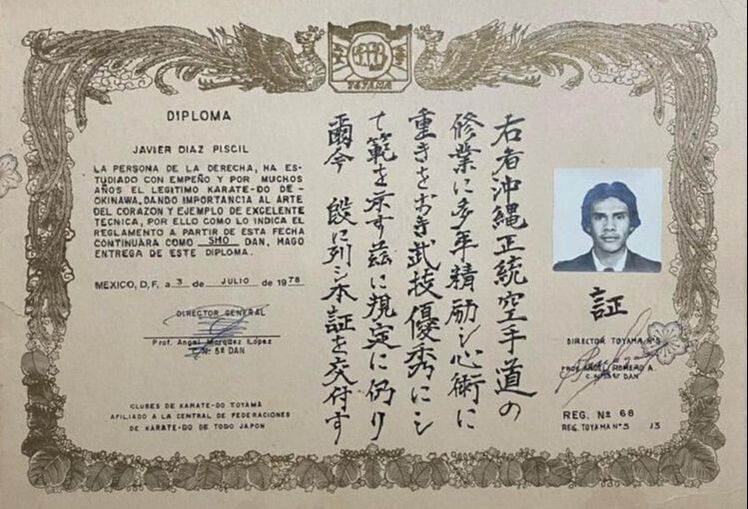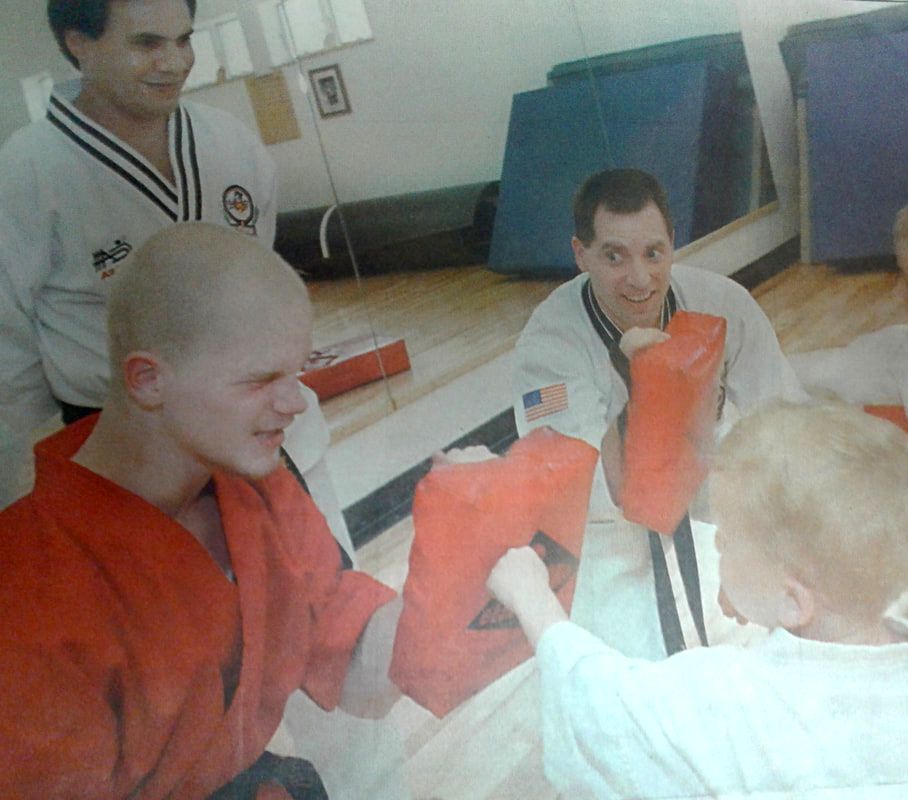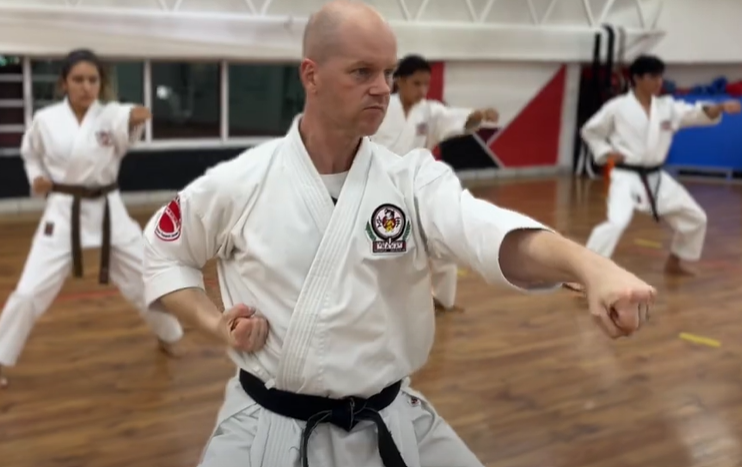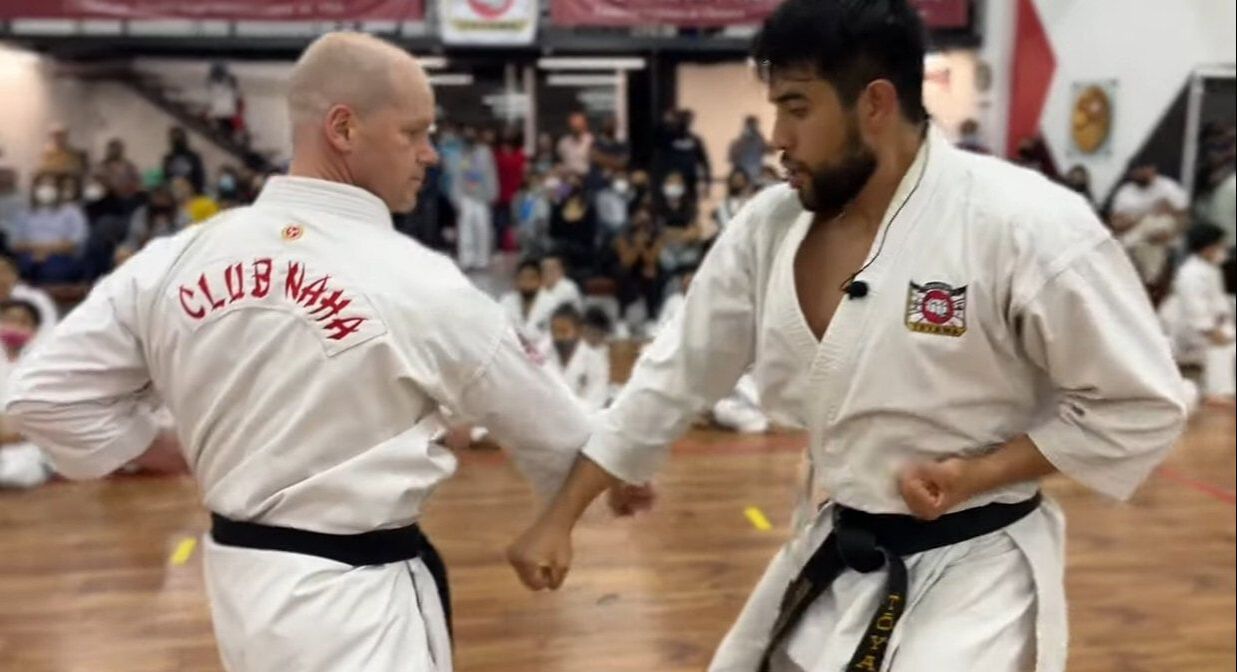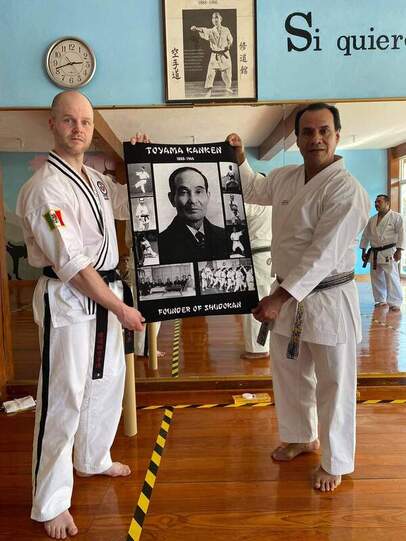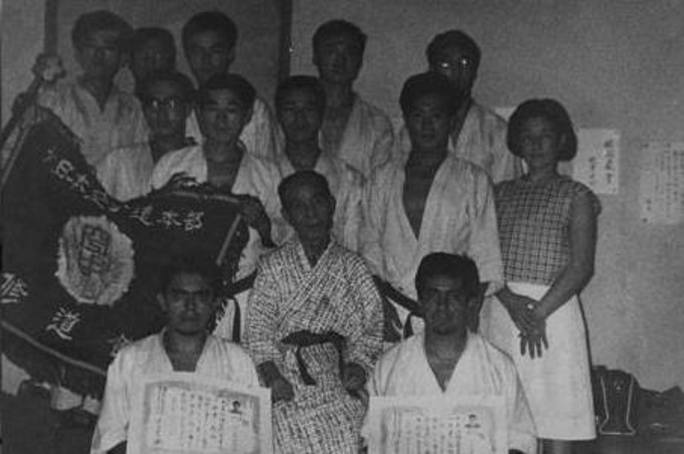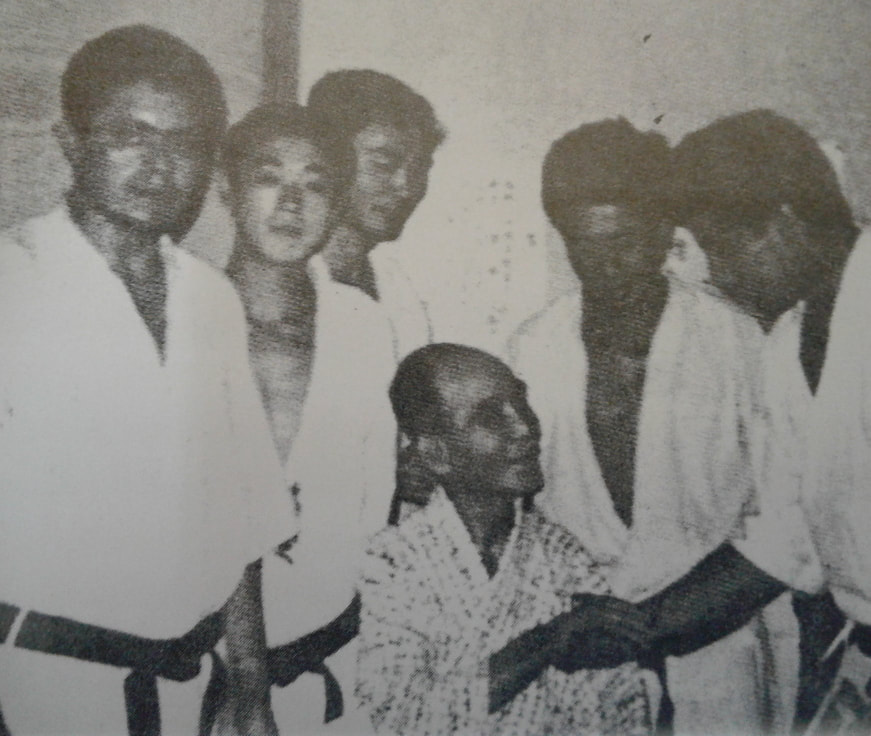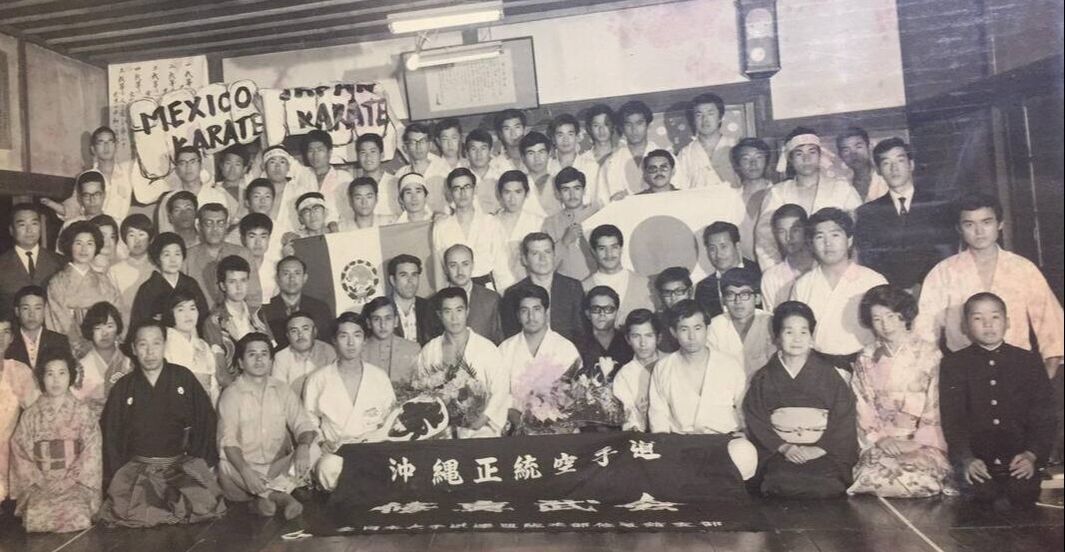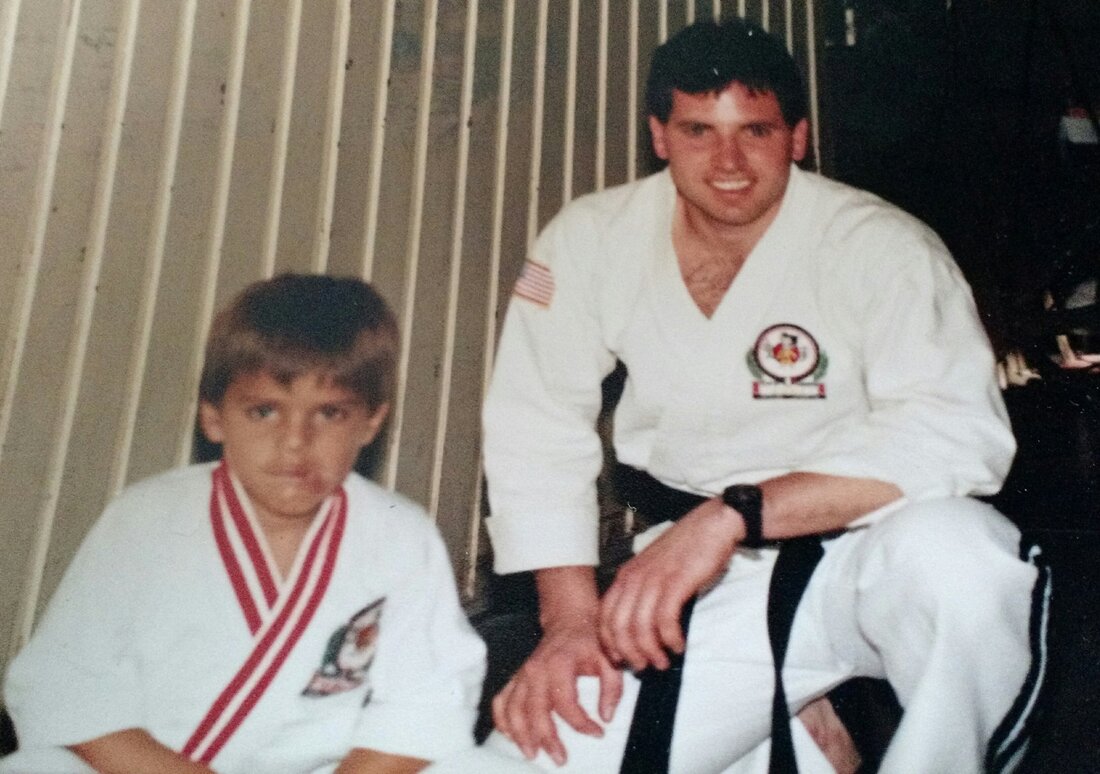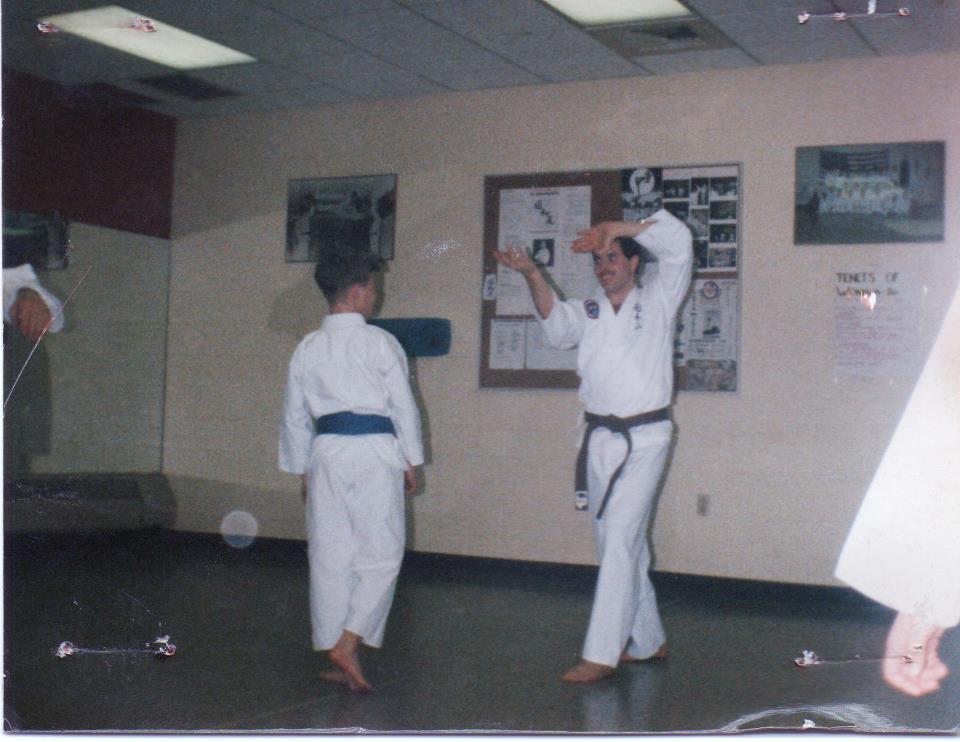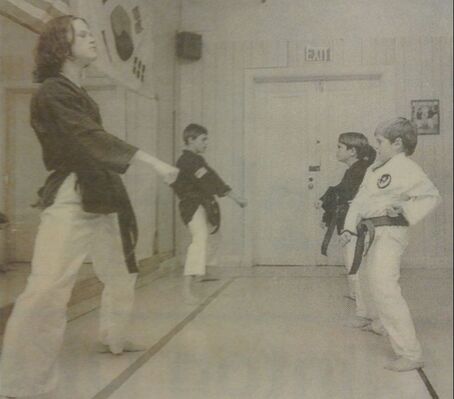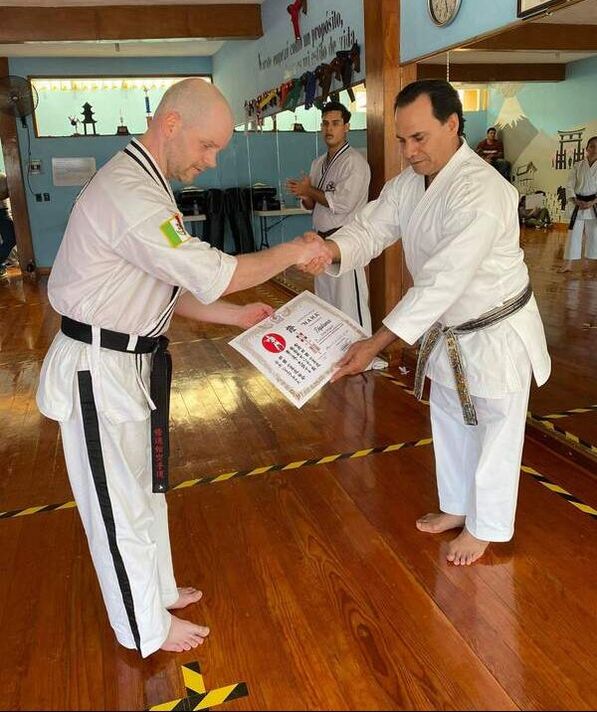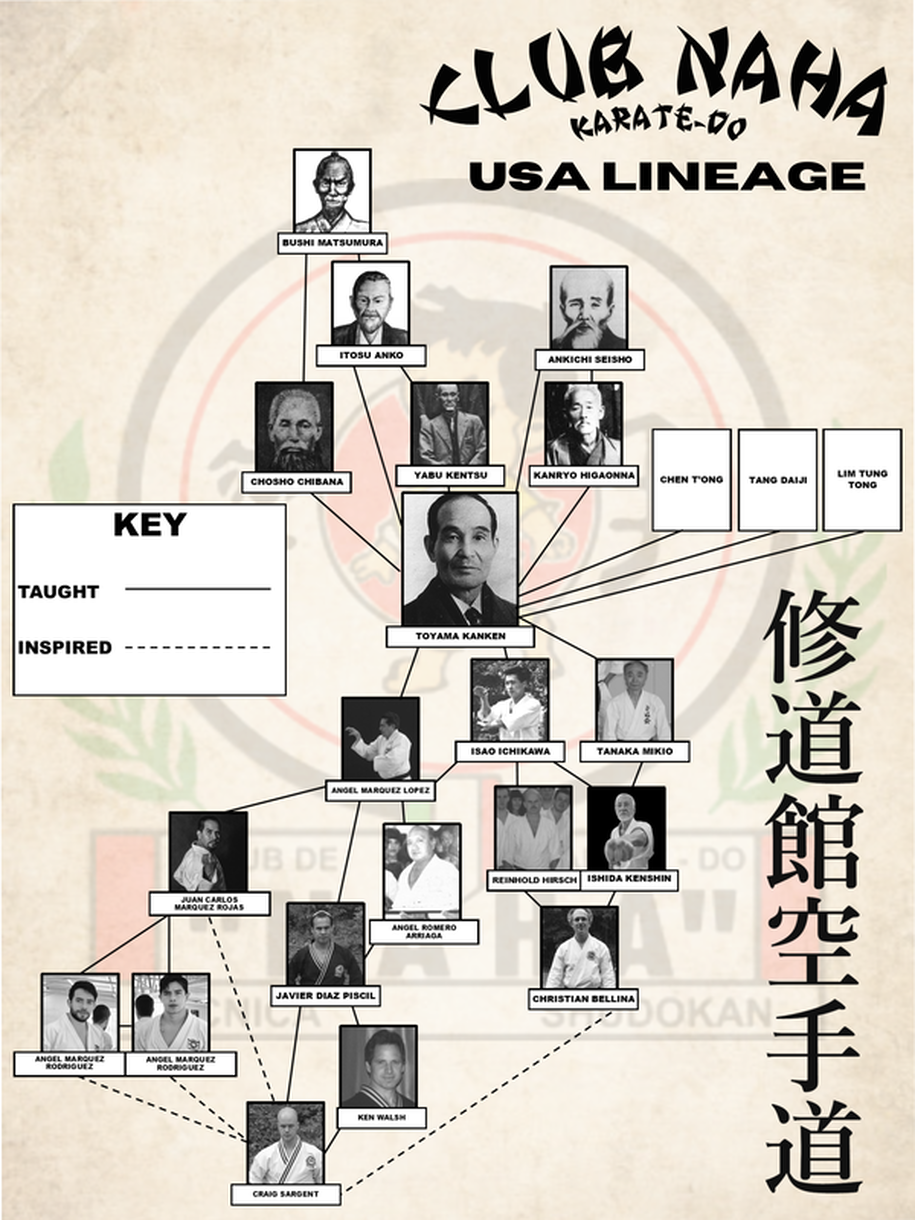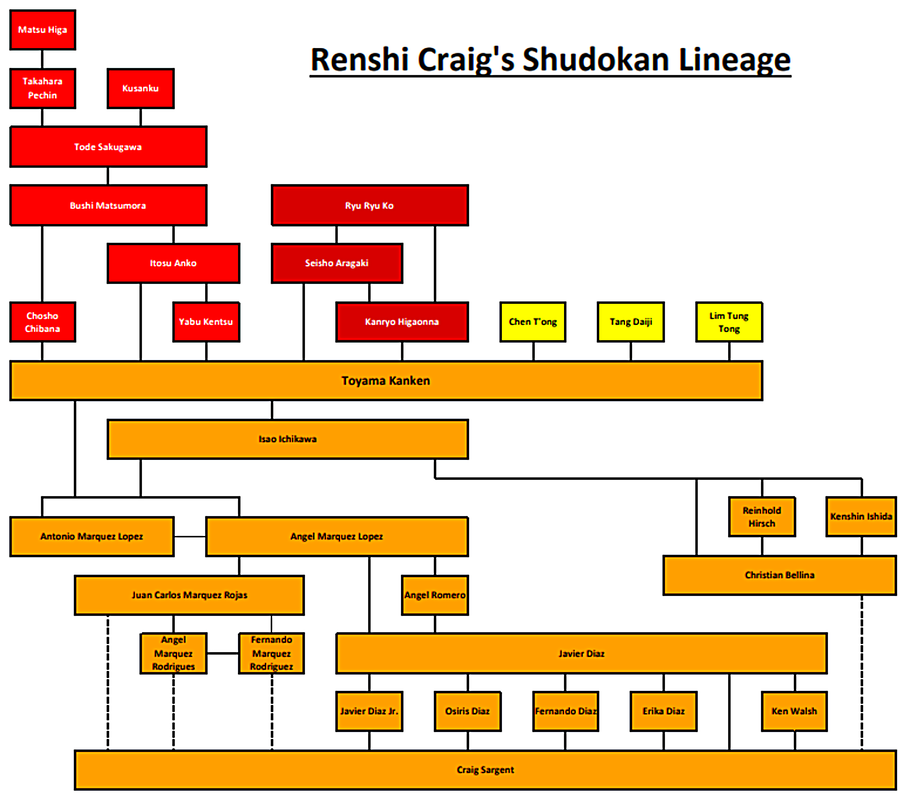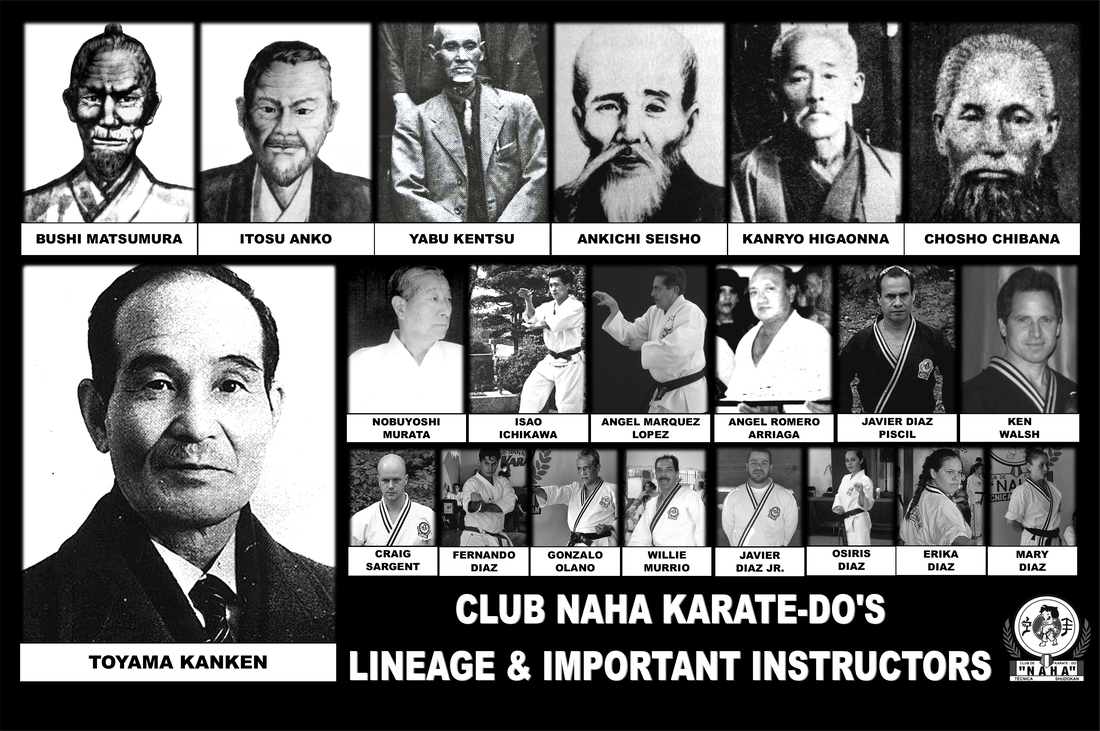A BRIEF HISTORY OF CLUB NAHA KARATE-DO USA
|
In the world of martial arts, traditions are often passed down through the generations, with stories of dedication, inspiration, and innovation defining the evolution of these ancient disciplines. One such remarkable tale is that of Club Naha Karate-Do, a martial arts school with a history that spans over five decades, touching two continents, and blending the wisdom of Japanese karate masters with Mexican spirit and American resilience.
More than 50 years ago, Angel Marquez Lopez and Antonio Marquez Lopez, a pair of aspiring martial artists from Mexico, embarked on a journey to Japan, driven by a profound desire to learn the art of karate from the legendary Toyama Kanken. Despite Toyama Kanken's advanced age at the time, he graciously accepted them as students alongside entrusting their care to Isao Ichikawa Sensei. This pivotal period saw them training under both Toyama Sensei and Ichikawa Sensei, shaping their karate journey before they pursued their individual paths. After returning to Mexico, Angel and Antonio decided to establish themselves in the world of karate. In 1969, they made the bold decision to part ways with their previous school, Doshinkan, and launched their own martial arts schools. Angel Marquez Lopez founded Toyama Karate-Do, and Antonio Marquez Lopez established the Okinawa Karate-Do dojo. This division marked the beginning of two distinct paths, each contributing to the rich tapestry of martial arts history. Shihan Javier Diaz Piscil, the founder of Club Naha Karate-Do, was deeply influenced by this historical chain of events. He began his karate training under the guidance of Angel Marquez Lopez, the founder of Toyama Karate-Do, and Sensei Angel Romero Arriaga in the 1970s. Through dedicated practice and unwavering determination, Shihan Javier earned his black belt in 1978, signifying his proficiency in the art. Over the years, Shihan Ken's dedication to karate led him to study under various martial arts instructors, each contributing to his evolving style. In 1992, he moved to Maine and established a Club Naha dojo, introducing the Hensan Ryu style to new students. Renshi Craig Sargent was one such student who quickly progressed to become an instructor and earned his black belts.
Shihan Javier Diaz's return to Maine in 1999 marked a pivotal moment in the school's history, as he introduced Shudokan Karate to Club Naha students. As time went on, Hensan Ryu, heavily influenced by Shudokan, gradually transformed into a style more akin to Shudokan Karate. In 2006, Shihan Ken promoted Renshi Craig to Head Instructor of Hensan Ryu, and Shudokan Karate's influence continued to grow within the dojo. In 2011 and 2012, Shihan Javier returned to Maine to teach Shudokan, further integrating this style into Club Naha's curriculum. With these changes in influence, the style was officially renamed Kai Naha Karate-Do, a testament to Shihan Javier Diaz's impact on the school. |
The turning point in the history of Club Naha Karate-Do occurred during a work trip when Shihan Javier and his crew made a stop in Iguala, Mexico. It was there, amidst the streets of this vibrant city, that Shihan Javier's vision was ignited. He stumbled upon a building that seemed perfect for his dream, a dojo to share his passion for karate. Inspired by this fateful discovery, on February 6th, 1982, he realized his dream and founded Club Naha Karate-Do, a name deeply rooted in the heart of Okinawa, the birthplace of karate.
In 1986, while residing in the USA for a brief period, Shihan Javier Diaz crossed paths with Shihan Ken Walsh, who worked at the New Rochelle Boys and Girls Club. The serendipitous encounter sparked a partnership that would change the trajectory of Club Naha Karate-Do. Shihan Javier introduced Shihan Ken to the world of karate, and together, they established a Club Naha Karate-Do dojo within the Boys and Girls Club. However, fate had other plans, as Shihan Javier had to return to Mexico later that year, leaving Shihan Ken without a karate instructor. Undeterred, Shihan Ken delved into martial arts, training in the style of Wonhwa-Do under Kensaku Takahashi. This marked the beginning of a journey that would lead to the creation of a new karate style, Hensan Ryu. As time passed, Renshi Craig continued to deepen his understanding of Shudokan Karate, culminating in his visit to the Club "NAHA" Karate-Do headquarters dojo in Iguala, Mexico. There, he was awarded his sixth-degree black belt in Shudokan Karate under the guidance of Shihan Javier Diaz. On March 1, 2021, Shudokan Karate became the primary style taught at Club Naha Karate-Do USA dojo, with Hensan Ryu still practiced as supplementary material.
The history of Club Naha Karate-Do is a remarkable tale of cultural exchange, dedication, and transformation. From the humble beginnings in Mexico to the streets of New Rochelle and the hallowed halls of Iguala, this martial arts school has evolved through the ages, leaving a lasting legacy that is firmly rooted in the spirit of its founders, instructors, and students. Club Naha Karate-Do is not just a dojo; it's a testament to the enduring power of martial arts to inspire and shape lives, no matter where they begin. |
At Club Naha Karate-Do, we proudly uphold a legacy of esteemed instructors who have significantly contributed to the development and global dissemination of karate. Here, we introduce the revered mentors affiliated with our dojo:
Soken "Bushi" Matsumura: Renowned for his profound expertise in Shuri-te, Matsumura's teachings serve as a timeless source of inspiration for practitioners across generations.
Itosu Anko: Celebrated for his instrumental role in popularizing karate within Okinawan schools and crafting the foundational Pinan Kata, Anko's contributions to karate pedagogy are invaluable.
Yabu Kentsu: A pioneering figure in extending karate's reach to mainland Japan, Kentsu's unwavering dedication played a pivotal role in the global recognition of Okinawan martial arts.
Ankichi Seisho (Aragaki Seisho): Revered for his profound understanding of combat principles, Seisho's teachings continue to resonate deeply within the martial arts community.
Kanryo Higaonna: A trailblazer in Naha-te and a seminal figure in the evolution of Goju-ryu, Higaonna's emphasis on internal energy and circular movements has profoundly shaped our understanding of karate.
Chosho Chibana: A steadfast guardian of Shorin-ryu karate, Chibana's commitment to preserving traditional techniques ensures the enduring legacy of Okinawan martial arts.
Toyama Kanken: The visionary founder of the Shudokan karate dojo, Kanken's comprehensive approach to martial arts education laid the groundwork for our dojo's teachings. He honed his craft under the tutelage of Itosu Anko, Yabu Kentsu, Ankichi Seisho, Kanryo Higaonna, Chosho Chibana, and received additional training from three kung fu instructors during his time in Taiwan.
Nobuyoshi Murata: A trailblazer who introduced karate to Mexico, Murata's efforts significantly contributed to the growth and popularity of karate in the region.
Isao Ichikawa: A devoted disciple of Toyama Kanken, Ichikawa's innovative creation of the Kyoku Kata showcases his dedication to pushing the boundaries of traditional karate training.
Angel Marquez Lopez: The visionary founder of Toyama Karate-Do in Mexico, Lopez's international endeavors have played a pivotal role in the global spread of karate. He received training under both Toyama Kanken and Isao Ichikawa.
Angel Romero Arriga: Enriching our dojo's teachings with his expertise, Arriga, a student of Angel Marquez Lopez and one of Javier Diaz's teachers, brings a wealth of knowledge to our community.
Javier Diaz Piscil: Instrumental in establishing Club Naha Karate-Do, Piscil's dedication to karate education fosters a community of martial artists committed to self-improvement and mutual respect. He received training under both Angel Marquez Lopez and Angel Romero Arriga.
Ken Walsh: Synthesizing his expertise in Shudokan and Wonhwa Do, Walsh's creation of Hensan Ryu reflects his innovative spirit and unwavering commitment to martial arts. He received training under Javier Diaz and Joon Ho Suek.
Craig Sargent: Guiding our dojo as the head instructor of Club Naha Karate-Do USA, Sargent seamlessly blends traditional and modern karate, empowering students with wisdom and dedication. He received training under Ken Walsh and Javier Diaz.
Fernando Diaz, Erika Diaz, Osiris Diaz, Javier Diaz Jr.: Embodying the Diaz family's dedication to karate, each of Javier Diaz's children brings unique talents and perspectives to our dojo, enriching our community. They received training under their father, Javier Diaz.
Gonzalo Olano: Inspiring fellow practitioners with his skill and dedication, Olano, a top student of Javier Diaz, contributes to the vibrant spirit of our dojo. He received training under Javier Diaz.
Willy Murillo: Exemplifying dedication to karate and its values, Murillo's leadership at the Club Naha Karate-Do dojo in Taxco, Mexico, reflects his unwavering commitment. He received training under Javier Diaz.
Mary Diaz: Creating a familial atmosphere within our dojo, Mary's presence and encouragement are integral to our community. She received training under her husband, Javier Diaz.
Together, these instructors form a diverse and dedicated team, united in their commitment to preserving the rich traditions of Okinawan karate and fostering a supportive community of martial artists at Club Naha Karate-Do.
Soken "Bushi" Matsumura: Renowned for his profound expertise in Shuri-te, Matsumura's teachings serve as a timeless source of inspiration for practitioners across generations.
Itosu Anko: Celebrated for his instrumental role in popularizing karate within Okinawan schools and crafting the foundational Pinan Kata, Anko's contributions to karate pedagogy are invaluable.
Yabu Kentsu: A pioneering figure in extending karate's reach to mainland Japan, Kentsu's unwavering dedication played a pivotal role in the global recognition of Okinawan martial arts.
Ankichi Seisho (Aragaki Seisho): Revered for his profound understanding of combat principles, Seisho's teachings continue to resonate deeply within the martial arts community.
Kanryo Higaonna: A trailblazer in Naha-te and a seminal figure in the evolution of Goju-ryu, Higaonna's emphasis on internal energy and circular movements has profoundly shaped our understanding of karate.
Chosho Chibana: A steadfast guardian of Shorin-ryu karate, Chibana's commitment to preserving traditional techniques ensures the enduring legacy of Okinawan martial arts.
Toyama Kanken: The visionary founder of the Shudokan karate dojo, Kanken's comprehensive approach to martial arts education laid the groundwork for our dojo's teachings. He honed his craft under the tutelage of Itosu Anko, Yabu Kentsu, Ankichi Seisho, Kanryo Higaonna, Chosho Chibana, and received additional training from three kung fu instructors during his time in Taiwan.
Nobuyoshi Murata: A trailblazer who introduced karate to Mexico, Murata's efforts significantly contributed to the growth and popularity of karate in the region.
Isao Ichikawa: A devoted disciple of Toyama Kanken, Ichikawa's innovative creation of the Kyoku Kata showcases his dedication to pushing the boundaries of traditional karate training.
Angel Marquez Lopez: The visionary founder of Toyama Karate-Do in Mexico, Lopez's international endeavors have played a pivotal role in the global spread of karate. He received training under both Toyama Kanken and Isao Ichikawa.
Angel Romero Arriga: Enriching our dojo's teachings with his expertise, Arriga, a student of Angel Marquez Lopez and one of Javier Diaz's teachers, brings a wealth of knowledge to our community.
Javier Diaz Piscil: Instrumental in establishing Club Naha Karate-Do, Piscil's dedication to karate education fosters a community of martial artists committed to self-improvement and mutual respect. He received training under both Angel Marquez Lopez and Angel Romero Arriga.
Ken Walsh: Synthesizing his expertise in Shudokan and Wonhwa Do, Walsh's creation of Hensan Ryu reflects his innovative spirit and unwavering commitment to martial arts. He received training under Javier Diaz and Joon Ho Suek.
Craig Sargent: Guiding our dojo as the head instructor of Club Naha Karate-Do USA, Sargent seamlessly blends traditional and modern karate, empowering students with wisdom and dedication. He received training under Ken Walsh and Javier Diaz.
Fernando Diaz, Erika Diaz, Osiris Diaz, Javier Diaz Jr.: Embodying the Diaz family's dedication to karate, each of Javier Diaz's children brings unique talents and perspectives to our dojo, enriching our community. They received training under their father, Javier Diaz.
Gonzalo Olano: Inspiring fellow practitioners with his skill and dedication, Olano, a top student of Javier Diaz, contributes to the vibrant spirit of our dojo. He received training under Javier Diaz.
Willy Murillo: Exemplifying dedication to karate and its values, Murillo's leadership at the Club Naha Karate-Do dojo in Taxco, Mexico, reflects his unwavering commitment. He received training under Javier Diaz.
Mary Diaz: Creating a familial atmosphere within our dojo, Mary's presence and encouragement are integral to our community. She received training under her husband, Javier Diaz.
Together, these instructors form a diverse and dedicated team, united in their commitment to preserving the rich traditions of Okinawan karate and fostering a supportive community of martial artists at Club Naha Karate-Do.
